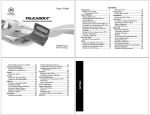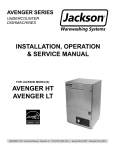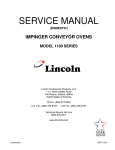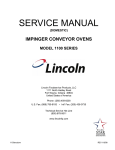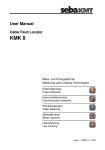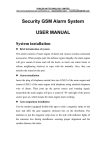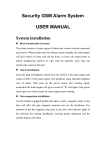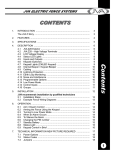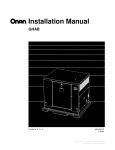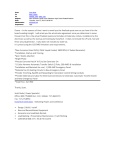Download 20 ES GENERATOR SET - Aaron Equipment Company
Transcript
20 ES GENERATOR SET Printed in U.S.A. 9280601 595 Redistribution or publication of this document by any means, is strictly prohibited. Table of Contents SECTION TITLE PAGE SAFETY PRECAUTIONS . . . . . . . . . . . . . . . . . . . . . . . . . . . . . . . . . . . . . . . . . iii, iv 1 INTRODUCTION . . . . . . . . . . . . . . . . . . . . . . . . . . . . . . . . . . . . . . . . . . . . . . . . . . 1-1 About This Manual . . . . . . . . . . . . . . . . . . . . . . . . . . . . . . . . . . . . . . . . . . . . . . . 1-1 Installation Overview . . . . . . . . . . . . . . . . . . . . . . . . . . . . . . . . . . . . . . . . . . . . . 1-1 2 SPECIFICATIONS . . . . . . . . . . . . . . . . . . . . . . . . . . . . . . . . . . . . . . . . . . . . . . . . . 2-1 3 MOUNTING THE GENERATOR SET . . . . . . . . . . . . . . . . . . . . . . . . . . . . . . . . 3-1 General . . . . . . . . . . . . . . . . . . . . . . . . . . . . . . . . . . . . . . . . . . . . . . . . . . . . . . . . Location . . . . . . . . . . . . . . . . . . . . . . . . . . . . . . . . . . . . . . . . . . . . . . . . . . . . . . . . Mounting . . . . . . . . . . . . . . . . . . . . . . . . . . . . . . . . . . . . . . . . . . . . . . . . . . . . . . . Access to Set . . . . . . . . . . . . . . . . . . . . . . . . . . . . . . . . . . . . . . . . . . . . . . . . . . . Vibration Isolators . . . . . . . . . . . . . . . . . . . . . . . . . . . . . . . . . . . . . . . . . . . . . . . 4 MECHANICAL CONNECTIONS . . . . . . . . . . . . . . . . . . . . . . . . . . . . . . . . . . . . 4-1 General . . . . . . . . . . . . . . . . . . . . . . . . . . . . . . . . . . . . . . . . . . . . . . . . . . . . . . . . Fuel System . . . . . . . . . . . . . . . . . . . . . . . . . . . . . . . . . . . . . . . . . . . . . . . . . . . . Exhaust System . . . . . . . . . . . . . . . . . . . . . . . . . . . . . . . . . . . . . . . . . . . . . . . . . Ventilation and Cooling . . . . . . . . . . . . . . . . . . . . . . . . . . . . . . . . . . . . . . . . . . . 5 4-1 4-1 4-5 4-6 ELECTRICAL CONNECTIONS . . . . . . . . . . . . . . . . . . . . . . . . . . . . . . . . . . . . . 5-1 General . . . . . . . . . . . . . . . . . . . . . . . . . . . . . . . . . . . . . . . . . . . . . . . . . . . . . . . . Transfer Switch . . . . . . . . . . . . . . . . . . . . . . . . . . . . . . . . . . . . . . . . . . . . . . . . . AC Wiring . . . . . . . . . . . . . . . . . . . . . . . . . . . . . . . . . . . . . . . . . . . . . . . . . . . . . . DC Wiring . . . . . . . . . . . . . . . . . . . . . . . . . . . . . . . . . . . . . . . . . . . . . . . . . . . . . . 6 3-1 3-1 3-2 3-4 3-4 5-1 5-1 5-2 5-3 PRESTART PREPARATIONS . . . . . . . . . . . . . . . . . . . . . . . . . . . . . . . . . . . . . . 6-1 General . . . . . . . . . . . . . . . . . . . . . . . . . . . . . . . . . . . . . . . . . . . . . . . . . . . . . . . . Lubrication . . . . . . . . . . . . . . . . . . . . . . . . . . . . . . . . . . . . . . . . . . . . . . . . . . . . . . Coolant . . . . . . . . . . . . . . . . . . . . . . . . . . . . . . . . . . . . . . . . . . . . . . . . . . . . . . . . Fuel . . . . . . . . . . . . . . . . . . . . . . . . . . . . . . . . . . . . . . . . . . . . . . . . . . . . . . . . . . . Ventilation . . . . . . . . . . . . . . . . . . . . . . . . . . . . . . . . . . . . . . . . . . . . . . . . . . . . . . Exhaust System . . . . . . . . . . . . . . . . . . . . . . . . . . . . . . . . . . . . . . . . . . . . . . . . . Electrical System . . . . . . . . . . . . . . . . . . . . . . . . . . . . . . . . . . . . . . . . . . . . . . . . Mechanical Checks . . . . . . . . . . . . . . . . . . . . . . . . . . . . . . . . . . . . . . . . . . . . . . i 6-1 6-1 6-1 6-1 6-1 6-1 6-1 6-1 Redistribution or publication of this document by any means, is strictly prohibited. SECTION 7 TITLE PAGE INITIAL START AND CHECKS . . . . . . . . . . . . . . . . . . . . . . . . . . . . . . . . . . . . . 7-1 Starting . . . . . . . . . . . . . . . . . . . . . . . . . . . . . . . . . . . . . . . . . . . . . . . . . . . . . . . . Engine Gauges . . . . . . . . . . . . . . . . . . . . . . . . . . . . . . . . . . . . . . . . . . . . . . . . . . AC Meters (If Equipped) . . . . . . . . . . . . . . . . . . . . . . . . . . . . . . . . . . . . . . . . . . Exhaust System . . . . . . . . . . . . . . . . . . . . . . . . . . . . . . . . . . . . . . . . . . . . . . . . . Engine Monitor Indicator Lamps . . . . . . . . . . . . . . . . . . . . . . . . . . . . . . . . . . . Fuel System . . . . . . . . . . . . . . . . . . . . . . . . . . . . . . . . . . . . . . . . . . . . . . . . . . . . DC Electrical System . . . . . . . . . . . . . . . . . . . . . . . . . . . . . . . . . . . . . . . . . . . . . Cooling System . . . . . . . . . . . . . . . . . . . . . . . . . . . . . . . . . . . . . . . . . . . . . . . . . Lubrication System . . . . . . . . . . . . . . . . . . . . . . . . . . . . . . . . . . . . . . . . . . . . . . 8 7-1 7-2 7-2 7-2 7-2 7-3 7-3 7-3 7-3 INSTALLATION CHECKLIST . . . . . . . . . . . . . . . . . . . . . . . . . . . . . . . . . . . . . . . 8-1 General . . . . . . . . . . . . . . . . . . . . . . . . . . . . . . . . . . . . . . . . . . . . . . . . . . . . . . . . Genset Support . . . . . . . . . . . . . . . . . . . . . . . . . . . . . . . . . . . . . . . . . . . . . . . . . Cooling Air Flow . . . . . . . . . . . . . . . . . . . . . . . . . . . . . . . . . . . . . . . . . . . . . . . . . Fuel System . . . . . . . . . . . . . . . . . . . . . . . . . . . . . . . . . . . . . . . . . . . . . . . . . . . . Exhaust System . . . . . . . . . . . . . . . . . . . . . . . . . . . . . . . . . . . . . . . . . . . . . . . . . AC and DC Wiring . . . . . . . . . . . . . . . . . . . . . . . . . . . . . . . . . . . . . . . . . . . . . . . Genset Prestart . . . . . . . . . . . . . . . . . . . . . . . . . . . . . . . . . . . . . . . . . . . . . . . . . ii 8-1 8-1 8-1 8-1 8-2 8-2 8-2 Redistribution or publication of this document by any means, is strictly prohibited. Safety Precautions • Be sure battery area has been well-ventilated Before operating the generator set, read the Operator’s Manual and become familiar with it and the equipment. Safe and efficient operation can be achieved only if the equipment is properly operated and maintained. Many accidents are caused by failure to follow fundamental rules and precautions. prior to servicing near it. Lead-acid batteries emit a highly explosive hydrogen gas that can be ignited by arcing, sparking, smoking, etc.. EXHAUST GASES ARE DEADLY • Provide an adequate exhaust system to properly expel discharged gases away from enclosed or sheltered areas and areas where individuals are likely to congregate. Visually and audibly inspect the exhaust daily for leaks per the maintenance schedule. Ensure that exhaust manifolds are secured and not warped. Do not use exhaust gases to heat a compartment. • Be sure the unit is well ventilated. The following symbols, found throughout this manual, alert you to potentially dangerous conditions to the operator, service personnel, or the equipment. This symbol warns of immediate hazards which will result in severe personal injury or death. WARNING This symbol refers to a hazard or unsafe practice which can result in severe personal injury or death. • Engine exhaust and some of its constituents are known to the state of California to cause cancer, birth defects, and other reproductive harm. CAUTION This symbol refers to a hazard or unsafe practice which can result in personal injury or product or property damage. MOVING PARTS CAN CAUSE SEVERE PERSONAL INJURY OR DEATH • Keep your hands, clothing, and jewelry away FUEL AND FUMES ARE FLAMMABLE Fire, explosion, and personal injury or death can result from improper practices. • • DO NOT fill fuel tanks while engine is running, unless tanks are outside the engine compartment. Fuel contact with hot engine or exhaust is a potential fire hazard. • • DO NOT permit any flame, cigarette, pilot light, spark, arcing equipment, or other ignition source near the generator set or fuel tank. • • Fuel lines must be adequately secured and free of leaks. Fuel connection at the engine should be made with an approved flexible line. Do not use copper piping on flexible lines as copper will become brittle if continuously vibrated or repeatedly bent. • • Be sure all fuel supplies have a positive shutoff valve. from moving parts. Before starting work on the generator set, disconnect battery charger from its AC source, then disconnect starting batteries, negative (-) cable first. This will prevent accidental starting. Make sure that fasteners on the generator set are secure. Tighten supports and clamps, keep guards in position over fans, drive belts, etc. Do not wear loose clothing or jewelry in the vicinity of moving parts, or while working on electrical equipment. Loose clothing and jewelry can become caught in moving parts. Jewelry can short out electrical contacts and cause shock or burning. If adjustment must be made while the unit is running, use extreme caution around hot manifolds, moving parts, etc. LS-11a iii Redistribution or publication of this document by any means, is strictly prohibited. GENERAL SAFETY PRECAUTIONS ELECTRICAL SHOCK CAN CAUSE SEVERE PERSONAL INJURY OR DEATH • Coolants under pressure have a higher boiling point than water. DO NOT open a radiator or heat exchanger pressure cap while the engine is running. Allow the generator set to cool and bleed the system pressure first. • Benzene and lead, found in some gasoline, have been identified by some state and federal agencies as causing cancer or reproductive toxicity. When checking, draining or adding gasoline, take care not to ingest, breathe the fumes, or contact gasoline. • Used engine oils have been identified by some state or federal agencies as causing cancer or reproductive toxicity. When checking or changing engine oil, take care not to ingest, breathe the fumes, or contact used oil. • DO NOT CONNECT GENERATOR SET DI- • RECTLY TO ANY BUILDING ELECTRICAL SYSTEM. Hazardous voltages can flow from the generator set into the utility line. This creates a potential for electrocution or property damage. Connect only through an approved isolation switch or an approved paralleling device. Provide appropriate fire extinguishers and install them in convenient locations. Consult the local fire department for the correct type of extinguisher to use. Do not use foam on electrical fires. Use extinguishers rated ABC by NFPA. • Make sure that rags are not left on or near the engine. • Remove all unnecessary grease and oil from the unit. Accumulated grease and oil can cause overheating and engine damage which present a potential fire hazard. • Keep the generator set and the surrounding area clean and free from obstructions. Remove any debris from the set and keep the floor clean and dry. • Do not work on this equipment when mentally or physically fatigued, or after consuming any alcohol or drug that makes the operation of equipment unsafe. • Substances in exhaust gases have been identified by some state or federal agencies as causing cancer or reproductive toxicity. Take care not to breath or ingest or come into contact with exhaust gases. • Remove electric power before removing protective shields or touching electrical equipment. Use rubber insulative mats placed on dry wood platforms over floors that are metal or concrete when around electrical equipment. Do not wear damp clothing (particularly wet shoes) or allow skin surface to be damp when handling electrical equipment. • Use extreme caution when working on electrical components. High voltages can cause injury or death. DO NOT tamper with interlocks. • Follow all applicable state and local electrical codes. Have all electrical installations performed by a qualified licensed electrician. Tag and lock open switches to avoid accidental closure. HIGH VOLTAGE GENERATOR SETS (1.9kV to 15kV) • High voltage acts differently than low voltage. Special equipment and training is required to work on or around high voltage equipment. Operation and maintenance must be done only by persons trained and qualified to work on such devices. Improper use or procedures will result in severe personal injury or death. • Do not work on energized equipment. Unauthorized personnel must not be permitted near energized equipment. Due to the nature of high voltage electrical equipment, induced voltage remains even after the equipment is disconnected from the power source. Plan the time for maintenance with authorized personnel so that the equipment can be de-energized and safely grounded. KEEP THIS MANUAL NEAR THE GENSET FOR EASY REFERENCE iv Redistribution or publication of this document by any means, is strictly prohibited. 1. Introduction your nearest Cummins/Onan dealer or distributor for assistance. ABOUT THIS MANUAL This manual provides installation instructions for the ES generator set. This includes the following information: Application and Installation A standby power system must be carefully planned and correctly installed for proper operation. This involves two essential elements: application and installation. Mounting Recommendations - Provides instructions for fastening generator set to base and space requirements for normal operation and service. Mechanical Connections - Shows location of connection points for fuel, exhaust, ventilation, and cooling. Electrical Connections – Shows location of electrical connection points for the control, generator, and starting system. Prestart – Provides checklist of items or procedures needed to prepare generator set for operation. Initial Startup – Describes test complete system to confirm proper installation, satisfactory performance, and proper operation. Refer to Operators Manual for troubleshooting information. Application (as it applies to generator set installations) refers to the design of the complete standby power system that usually includes power distribution equipment, transfer switches, ventilation equipment, mounting pads, and cooling, exhaust, and fuel systems. Each component must be correctly designed so the complete system will function as intended. Application and design is an engineering function generally done by specifying engineers or other trained specialists. Specifying engineers are responsible for the design of the complete standby system and for selecting the materials and products required. Installation refers to the actual set-up and assembly of the standby power system. The installers set up and connect the various components of the system as specified in the system design plan. The complexity of the standby system normally requires the special skills of qualified electricians, plumbers, sheetmetal workers, etc. to complete the various segments of the installation. This is necessary so all components are assembled using standard methods and practices. Installation Checklist - Provides reference checks upon completion of installation. This manual DOES NOT provide application information for selecting a generator set or designing the complete installation. If it is necessary to design the various integrated systems (fuel, exhaust, cooling, etc.), review standard installation practices, or specify system materials, additional information is required. For engineering data specific to the generator set, refer to the specification and product data sheets. For application information, refer to Application Manual T-030, ”Liquid Cooled Generator Sets”, available from Onan. Safety Considerations The generator set has been carefully designed to provide safe and efficient service when properly installed and operated. However, the overall safety and reliability of the complete system is dependent on many factors outside the control of the generator set manufacturer. To avoid possible safety hazards, make all mechanical and electrical connections to the generator set exactly as specified in this manual. All systems external to the generator (fuel, exhaust, electrical, etc.) must comply with all applicable codes. Make certain all required inspections and tests have been completed and all code requirements have been satisfied before certifying the installation is complete and ready for service. INSTALLATION OVERVIEW These installation recommendations apply to typical installations with standard model generator sets. Whenever possible, these recommendations also cover factory designed options or modifications. However, because of the many variables in any installation, it is not possible to provide specific recommendations for every situation. If there are any questions not answered by this manual, contact 1-1 Redistribution or publication of this document by any means, is strictly prohibited. 1-2 Redistribution or publication of this document by any means, is strictly prohibited. 2. Specifications ENGINE . . . . . . . . . . . . . . . . . . . . . . . . . . . . . . . . . Onan Modified Ford, 4-cylinder, LRG-423 FUEL Fuel . . . . . . . . . . Natural gas, Propane, Unleaded Gasoline, or a combination of two fuels Natural Gas Consumption at Full Load 60 Hz . . . . . . . . . . . . . . . . . . . . . . . . . . . . . . . . . . . . . . . . . . . . . . . . . . . . . . 301 cfh (8.5 m/h) 50 Hz . . . . . . . . . . . . . . . . . . . . . . . . . . . . . . . . . . . . . . . . . . . . . . . . . . . . . . 250 cfh (7.1 m/h) Propane (Vapor) Consumption at Full Load 60 Hz . . . . . . . . . . . . . . . . . . . . . . . . . . . . . . . . . . . . . . . . . . . . . . . . . . . . . . 103 cfh (2.9 m/h) 50 Hz . . . . . . . . . . . . . . . . . . . . . . . . . . . . . . . . . . . . . . . . . . . . . . . . . . . . . . . . 85 cfh (2.4 m/h) Gasoline Consumption at Full Load 60 Hz . . . . . . . . . . . . . . . . . . . . . . . . . . . . . . . . . . . . . . . . . . . . . . . . . . 2.7 US gph (10.2 L/h) 50 Hz . . . . . . . . . . . . . . . . . . . . . . . . . . . . . . . . . . . . . . . . . . . . . . . . . . . . 2.5 US gph (9.5 L/h) Maximum Natural Gas or LPG Supply Pressure . . . . 12 inches (305 mm) Water Column Natural Gas Supply Connection . . . . . . . . . . . . . . . . . . . . . . . . . . . . . . . . . . . . . 3/4 inch NPT Propane Vapor Supply Connection . . . . . . . . . . . . . . . . . . . . . . . . . . . . . . . . . . . 3/4 inch NPT LPG Liquid Supply Connection . . . . . . . . . . . . . . . . . . . . . . . . . . . . . . . . . . . . . . 1/4 inch NPT Maximum Gasoline Fuel Pump Lift . . . . . . . . . . . . . . . . . . . . . . . . . . . . . . . . . . . 3 feet (0.9 m) Gasoline Supply Hose I. D. . . . . . . . . . . . . . . . . . . . . . . . . . . . . . . . . . . . . . . . . . . . . 5/16 inch BATTERY Required Battery Voltage . . . . . . . . . . . . . . . . . . . . . . . . . . . . . . . . . . . . . . . . . . . . . . . . 12 VDC Recommended Battery Rating - Cold Cranking Amps . . . . . . . . . . . . . . . . . . . . . . . . . . 660 OIL AND COOLANT CAPACITY Engine Oil Capacity (Includes Filter) . . . . . . . . . . . . . . . . . . . . . . . . . . 4.5 U.S. quarts (4.0 L) Engine Coolant Capacity . . . . . . . . . . . . . . . . . . . . . . . . . . . . . . . . . 11.5 U.S. quarts (11.0 L) TUNE-UP SPECS Spark Plug Gap . . . . . . . . . . . . . . . . . . . . . . . . . . . . . 0.032 to 0.036 inches (0.8 to 0.9 mm) IMPORTANT! DEPENDING ON YOUR LOCATION AND INTENDED USE, FEDERAL, STATE OR LOCAL LAWS AND REGULATIONS MAY REQUIRE YOU TO OBTAIN AN AIR QUALITY EMISSIONS PERMIT BEFORE BEGINNING INSTALLATION OF YOUR GENERATOR SET. BE SURE TO CONSULT LOCAL POLLUTION CONTROL OR AIR QUALITY AUTHORITIES BEFORE COMPLETING YOUR CONSTRUCTION PLANS. 2-1 Redistribution or publication of this document by any means, is strictly prohibited. 2-2 Redistribution or publication of this document by any means, is strictly prohibited. 3. Mounting the Generator Set • • • • • GENERAL Most generator set installations must be engineered so the generator set will function properly under the expected load conditions. Use these instructions as a general guide only. Follow the instructions of the consulting engineer when locating or installing any components. The complete installation must comply with all local and state building codes, fire ordinances, and other applicable regulations. Electrical connections Accessibility for operation and servicing Noise levels Vibration isolation LOCATION Generator set location is decided mainly by related systems such as ventilation, wiring, fuel, and exhaust. The set should be located as near as possible to the main power fuse box. Requirements to be considered prior to installation: • • • • Discharge of exhaust gases Level mounting surface Adequate cooling air Provide a location away from extreme ambient temperatures and protect the generator set from adverse weather conditions. An optional housing is available for outside operation. Adequate fresh induction air Discharge of circulated air 3-1 Redistribution or publication of this document by any means, is strictly prohibited. MOUNTING FLAT WASHER Generator sets are mounted on a steel skid that provides proper support. The engine-generator assembly is isolated from the skid frame by rubber mounts that provide adequate vibration isolation for normal installations. For critical installations, install vibration isolators between the skid base and foundation. HEX NUT SKID Mount the genset on a substantial and level base such as a concrete pad. Use 3/4-inch diameter, anchored mounting bolts to secure the generator set skid to the floor to prevent movement. Secure the skid using a flat washer and a hex nut for each bolt (Figure 3-1). 12 INCH (305 mm) MOUNTING BOLT M1627 FIGURE 3-1. BOLT DIAGRAM 3-2 Redistribution or publication of this document by any means, is strictly prohibited. THE MUFFLER IS SUPPORTED INDEPENDENTLY OF THE ENGINE AN EXHAUST THIMBLE IS USED TO PASS THE EXHAUST PIPE THROUGH A COMBUSTIBLE WALL TRANSFER SWITCH FLEXIBLE EXHAUST TUBE RADIATOR DISCHARGE AIR DUCT CONTROL PANEL MANUAL GAS SUPPLY SHUTOFF VALVE LINE CIRCUIT BREAKER GAS FILTER FRESH AIR FLOW CRANKING BATTERY FLEXIBLE GAS SUPPLY HOSE POWER SUPPLY AND CONTROL WIRING ARE ROUTED SEPARATELY M-1896s FIGURE 3-2. TYPICAL INSTALLATION 3-3 Redistribution or publication of this document by any means, is strictly prohibited. 4. Once the genset is in position, the isolators may require adjusting so that the set is level. The isolators are adjusted by inserting the leveling bolt through the skid and into the isolator (the leveling bolt’s locking nut should be threaded up towards the bolt head). ACCESS TO SET Plan for access to the genset for servicing and provide adequate lighting around the unit. For convenience in general servicing such as the radiator, fan belt and changing the crankcase oil, the surface of the mounting base should be at least 6 inches (152 mm) above the floor. The leveling bolt will adjust the clearance between the top plate and the isolator base. A nominal clearance of 0.25 inch (6 mm) or greater is desired. This will provide sufficient clearance for the rocking that occurs during startup and shutdown. If the 0.25 inch (6 mm) clearance is not present, turn the leveling bolt until the desired clearance is achieved. VIBRATION ISOLATORS Installation and Adjustment Procedure 1. Place the vibration isolators (Figure 3-3) on the genset support structure. The isolators should be shimmed or grouted to ensure that all of the isolator bases are within 0.25 inch (6 mm) elevation of each other. The surface that the isolator bases rest on must also be flat. 2. Loosen the side snubber lock nuts so that the top plate of the isolator is free to move vertically and horizontally. Be sure that the top plate is correctly aligned with the base and springs. 3. Place the genset onto the isolators while aligning the skid’s mounting with the threaded isolator hole. The top plates will move down and approach the base of the isolator as load is applied. 5. The genset may not be level yet; therefore, adjust the leveling bolts until the set is level and sufficient clearance still remains. Once all isolators have been set, lock the leveling bolt in place with the lock nut. 6. The snubber nuts may remain loose and therefore provide better isolation between the genset and support structure. GENSET SKID LEVELING BOLT LOCK NUT 0.25 INCH (6 mm) CLEARANCE SNUBBER BASE M1828-1s M1828-1s FIGURE 3-3. VIBRATION ISOLATORS 3-4 Redistribution or publication of this document by any means, is strictly prohibited. 4. Mechanical Connections • Install a manual fuel shut-off valve at the outlet GENERAL of an above-ground fuel tank to facilitate service. • For a combination gas/gasoline set, provide a manual shut-off valve in each fuel line. Plug unused fuel inlet. The air/fuel ratio will be upset if both fuels are available at the same time or if air enters an unused fuel inlet, resulting in poor performance. • Do not use galvanized piping, fittings or tanks. The zinc coating reacts with elements in the fuel, resulting in contamination of the fuel. The generator set mechanical system installation includes connecting the fuel, exhaust, ventilation and cooling systems. Before starting any type of fuel installation, all pertinent state and local codes must be complied with and the installation must be inspected before the unit is put in service. FUEL SYSTEM Sets can be equipped to operate on gasoline only, LPG (propane), gasoline/natural gas, gasoline/ LPG and LPG/natural gas combinations. Figures 4-1 and 4-2 illustrate the fuel system components for various generator set configurations. A fuel selector switch may be provided for fuel changeover. (The position of the switch determines which fuel valve will open when the set is operated.) Gasoline Fuel WARNING Fuel presents the hazard of fire or explosion which can result in severe personal injury or death. Do not smoke or allow any flame, spark, pilot light, arc–producing equipment, or switch, or other ignition sources around fuel or fuel components, or in the installation area or areas with shared ventilation. Keep a type ABC fire extinguisher nearby. The following items should be considered when installing a fuel supply system: • Install an approved flexible fuel line at the fuel The gasoline-carbureted fuel system delivers a mixture of fuel and air to the combustion chamber. The system draws fuel from a tank, delivers it through a filter and fuel pump, to the carburetor float chamber. Air passing through the carburetor venturi draws fuel from the the float chamber. inlet to allow the set to rock on its mounts. Do not use copper tubing as a flexible fuel line - it will crack and spill gasoline. • The highest fuel level in the fuel tank must be lower than the inlet of the fuel pump to prevent spillage of fuel if a leak occurs (because of a faulty connection, ruptured pump diaphragm, etc.). See Specifications section for gasoline inlet size. Fuel lift should not exceed 3 feet (0.9 m). The recommendations in Onan publication T030, the Application Manual for Liquid-Cooled Generator Sets, should be followed in regard to fuel supply system pipe sizes and manual shutoff valves. • Provide a separate fuel line for each set served by the same fuel tank to prevent either set from being starved for fuel. 4-1 Redistribution or publication of this document by any means, is strictly prohibited. See Specifications section for natural gas/LPG fuel inlet size. The recommendations in Onan publication T030, the Application Manual for Liquid-Cooled Generator Sets, should be followed in regard to fuel supply system pipe sizes,manual shutoff valves, fuel filters and gas pressure regulators. Natural Gas/LPG Vapor/LPG Liquid Fuel System WARNING Natural gas and LPG vapor are highly flammable. LPG vapor is heavier than air. Do not bleed lines so fumes can collect in low areas. Do not smoke or allow any flame, spark, arcing switch or equipment, pilot light, or other source of ignition around fuel lines. Gas Pressure: The fuel regulators in each line provide constant gas pressure at the gas mixer under varying load conditions (approximately 5 inches WC for natural gas and –1.5 inches WC for LPG). There is a pressure test port on the supply side of the gas mixer for measuring fuel inlet pressure. A combination gasoline-gaseous fuel carburetor or straight gaseous fuel carburetors are available for use with gaseous fuels. A gaseous fuel system uses a fuel regulator to control the flow of gas from the lines to the carburetor. At the carburetor, the gaseous fuel is mixed with the incoming air. The maximum permissible fuel supply pressure is 20 inches WC (water column) and the minimum is 10 inches WC. This applies to LPG as well as to natural gas. The minimum pressure refers to supply pressure under rated load (maximum gas flow). There is a pressure test port on the supply side of each fuel regulator for measuring fuel supply pressure. Gaseous-fuel supply system design, materials, components, fabrication, assembly, installation, testing, inspection, operation and maintenance must comply with the applicable codes. See MFPA Standards No. 37, No. 54 and No. 58. 4-2 Redistribution or publication of this document by any means, is strictly prohibited. GAS MIXER LPG FLOW ADJUSTMENT COCK NATURAL GAS FUEL REGULATOR NATURAL GAS FUEL VALVE PRESSURE SWITCH LPG FUEL REGULATOR LPG FUEL VALVE FUEL SELECTION SWITCH PLUG IN NATURAL GAS SUPPLY INLET PLUG IN LPG SUPPLY INLET CARBURETOR GASOLINE FUEL FILTER FUEL PUMP GASOLINE SUPPLY INLET FIGURE 4-1. GASOLINE/NATURAL GAS/LPG VAPOR FUEL SYSTEM 4-3 Redistribution or publication of this document by any means, is strictly prohibited. NATURAL GAS FUEL REGULATOR LPG FLOW ADJUSTMENT COCK NATURAL GAS FUEL VALVE GAS MIXER PRESSURE SWITCH LPG LIQUID CONVERTOR FUEL SELECTION SWITCH PLUG IN NATURAL GAS SUPPLY INLET GASOLINE FUEL FILTER CARBURETOR PLUG IN LPG SUPPLY INLET FUEL PUMP GASOLINE SUPPLY INLET FIGURE 4-2. GASOLINE/NATURAL GAS/LPG LIQUID FUEL SYSTEM 4-4 Redistribution or publication of this document by any means, is strictly prohibited. CAUTION Weight applied to the engine manifold can result in turbocharger damage. Support the muffler and exhaust piping so no weight or stress is applied to engine exhaust elbow. EXHAUST SYSTEM Pipe exhaust gases to the outside of any enclosure. Locate the exhaust outlets away from any air inlets to avoid gases re-entering the enclosure. Exhaust installations are subject to various detrimental conditions such as extreme heat, infrequent operation and light loads. Regularly inspect the exhaust system both visually and audibly to see that the entire system remains fume tight and safe for operation. DRIP CAP RAIN CAP HOLES IN END OF INNER SLEEVE WARNING Inhalation of exhaust gases can result in severe personal injury or death. Use extreme care during installation to provide a tight exhaust system. Terminate exhaust pipe away from enclosed areas, windows, doors and vents. 9 INCH MIN (230 mm) VERTICAL ROOF 9 INCH MIN (230 mm) Use an approved thimble (Figure 4-3) where exhaust pipes pass through wall or partitions. Refer to NFPA 37, Section 6-3. ”Stationary Combustion Engines and Gas Turbines” for accepted design practices. Build according to the code requirements in effect at the installation site. HORIZONTAL WARNING Inhalation of exhaust gases can result in severe personal injury or death. Do not use exhaust heat to warm a room, compartment or storage area. WALL OR PARTITION EXS1036 Rain caps are available for the discharge end of vertical exhaust pipes. The rain cap clamps onto the end of the pipe and opens due to exhaust discharge force from the generator set. When the generator set is stopped, the rain cap automatically closes, protecting the exhaust system from rain, snow, etc. Check the rain cap periodically for proper operation (cap is not stuck closed). FIGURE 4-3. MOUNTING EXHAUST THIMBLE Use a section of flexible exhaust pipe between the engine and remainder of exhaust system. Support exhaust system to eliminate weight applied to engine exhaust outlet elbow/turbocharger connection. 4-5 Redistribution or publication of this document by any means, is strictly prohibited. Avoid sharp bends by using sweeping, long radius elbows and provide adequate support for muffler and tailpipe. Pitch a horizontal run of exhaust pipe DOWNWARD to allow any moisture condensation to drain away from the engine. If an exhaust pipe must be turned upward, install a condensation trap at the point where the rise begins (Figure 4-4). IF EXHAUST LINE MUST BE PITCHED UPWARD, CONSTRUCT A TRAP AT POINT OF RISE AVOID SHARP BENDS Shield or insulate exhaust lines if there is danger of personal contact. Allow at least 12 inches (305 mm) of clearance if the pipes pass close to a combustible wall or partition. DRAIN CONDENSATION TRAP PERIODICALLY WARNING Exhaust pipes are very hot and they can cause severe personal injury or death from direct contact or from fire hazard. Shield or insulate exhaust pipes if there is danger of personal contact or when routed through walls or near other combustible materials. EXS1046s FIGURE 4-4. CONDENSATION TRAP VENTILATION AND COOLING Generator sets create considerable heat that must be removed by proper ventilation. Outdoor installations rely on natural air circulation but indoor installations need properly sized and positioned vents for required airflow. Vents and Ducts For indoor installations, locate vents so incoming air passes through the immediate area of the installation before exhausting. Install the air outlet higher than the air inlet to allow for convection air movement. Size the vents and ducts so they are large enough to allow the required flow rate of air. The ”free area” of ducts must be as large as the exposed area of the radiator. Refer to the ES series Product Data Sheets for the airflow requirements. CS1366 FIGURE 4-5. WIND BARRIER Wind will restrict free airflow if it blows directly into the air outlet vent. Locate the outlet vent so the effects of wind are eliminated. See Figure 4-5. 4-6 Redistribution or publication of this document by any means, is strictly prohibited. Standard Radiator Cooling uses a set mounted radiator and engine pusher fan to cool engine water jacket. Air travels from the generator end of the set, across the engine and out through the radiator. An integral discharge duct adapter flange surrounds the radiator grille. Dampers Dampers or louvres protect the genset and equipment room from the outside environment. Their operation of opening and closing should be controlled by operation of the genset. Set Mounted Heat Exchanger Cooling uses a liquid-to-liquid heat exchanger that requires a connection to a supply of pressurized cold water and to a drain to discharge the water when it has passed through the heat exchanger. The engine coolant pump pumps coolant through the closed, pressurized loop between the engine and heat exchanger. In cooler climates movable or discharge dampers are used. These dampers allow the air to be recirculated back to the equipment room. This enables the equipment room to be heated by the generator set when operating. The cold water supply line should have a manual shutoff valve, water strainer and 12 VDC water solenoid valve to shut off the water supply when the engine is not running. A thermostatic water flow valve is also recommended. See Application Manual T-030 for more information. Radiator Set Requirements Radiator set cooling air is drawn past the rear of the set by a pusher fan that blows air through the radiator (Figure 4-6). Locate the air inlet to the rear of the set. Make the inlet vent opening 1-1/2 times larger than the radiator area. It is important that the inlet and outlet (louvers) do not restrict the cooling air flow beyond the capability of the engine cooling fan. If this capability is exceeded, engine will overheat. A powered ceiling vent will probable be required for ventilating the generator room. Remote Radiator Cooling (Optional) substitutes a remote mounted radiator and an electrically driven fan for the set mounted components. Removal of the radiator and the fan from the set reduces noise levels without forcing dependence on a continuous cooling water supply. The remote radiator installation must be completely protected against freezing. Locate the cooling air outlet directly in front of the radiator and as close as possible. The outlet opening must be at least as large as the radiator area. Length and shape of the air outlet duct should offer minimum restriction to airflow. Remote radiator plumbing will vary with installation. Follow recommendations given in Application Manual T-030. See product data sheet for friction head and static head limits. The radiator has an air discharge duct adapter flange. Attach a canvas or sheet metal duct to the flange and the air outlet opening using screws and nuts so duct can be removed for maintenance purposes. The duct prevents recirculation of heated air. Before installing the duct, remove the radiator core guard. Before filling cooling system, check all hardware for security. This includes hose clamps, capscrews, fittings and connections. Use flexible coolant lines with heat exchanger, standpipe or remote mounted radiator. 4-7 Redistribution or publication of this document by any means, is strictly prohibited. THERMOSTATIC AIR RECIRCULATING DAMPER* WIND/ NOISE BARRIER INLET AIR DAMPER HOT AIR COOL AIR D DISTANCE SHOULD NOT BE LESS THAN HEIGHT OF RADIATOR FLEXIBLE DUCT CONNECTOR RADIATOR * Louvers should close when room ambient is above 60° F (16° C) FIGURE 4-6. TYPICAL RADIATOR SET INSTALLATION 4-8 Redistribution or publication of this document by any means, is strictly prohibited. 5. Electrical Connections GENERAL The genset electrical system includes connecting the load, installing the control wiring and connecting the batteries. Connect the batteries last to avoid accidental starting of the unit during installation. LOAD NORMAL SOURCE CAUTION To prevent arcing, always disconnect a battery charger from its AC source before disconnecting the battery cables. Otherwise, disconnecting the cables can result in voltage spikes high enough to damage the DC control circuits of the set. GENSET NOTE: SHOWN WITH LINE CONNECTED TO LOAD WARNING Accidental starting of the generator set while working on it can cause severe personal injury or death. Prevent accidental starting by disconnecting the starting battery cables (negative [–] first). FIGURE 5-1. TYPICAL LOAD TRANSFER SWITCH Arcing can ignite the explosive hydrogen gas given off by batteries, causing severe personal injury. Arcing can occur if the negative (–) battery cable is connected and a tool being used to connect or disconnect the positive (+) battery cable accidentally touches the frame or other grounded metal part of the set. To prevent arcing, always remove the negative (–) cable first, and reconnect it last. Most local regulations require that wiring connections be made by a licensed electrician and the installation be inspected and approved before operation. All connections, wire sizes, etc. must conform to the requirements of all electrical codes in effect at the installation site. WARNING Improper wiring can cause a fire or electrocution, resulting in severe personal injury or death and/or property and equipment damage. TRANSFER SWITCH If the installation is for standby service, a transfer switch is required for switching the load from the normal power source to the generator set (Figure 5-1). Either a manual or automatic switch can be used. Follow the installation instructions provided with the transfer switch when connecting the load and control wiring. 5-1 Redistribution or publication of this document by any means, is strictly prohibited. connection Diagram to identify the output leads that must be routed through each current transformer, and also appropriate transformer post selection for meter sensing leads. AC WIRING Generator Voltage Connections The generator output voltage and maximum current rating are specified on the generator set nameplate. Line-to-neutral voltage is always the lower voltage shown and line-to-line voltage is the higher rating. Load Balancing When connecting loads to the generator set, balance the loads so the current flow from each line terminal (L1, L2 and L3) is about the same. This is especially important if both single phase and three phase loads are connected. Any combination of single phase and three phase loading can be used as long as each line current is within 10 percent of median value and no line current exceeds the nameplate rating of the generator. Check the current flow from each line by observing the control panel ammeter. These generators can be configured for the voltages shown in the Reconnection Diagram. Most of these voltages must be reconnected by the installer to give the voltage required by the installation. Before shipping, the factory tests the generator set output by connecting the generator to produce a particular test voltage. The generator may be connected at the factory to produce a specified voltage per customer order. The installer must always check the stator lead terminal connections and perform any necessary reconnect to obtain the voltage desired. Note that some voltages are available only on certain specific generators. Grounding Grounding involves making a conducting connection between the metal parts of the generator set or one of its electrical circuits and the earth. The design and installation of a grounding system is affected by many factors such as the use of multiple transformers, ground fault protection requirements and physical location of the generator. Follow the recommendations of the consulting engineer when installing the grounding system. Refer to Reconnection Diagram when reviewing the voltage connection information and use the electrical schematic supplied with your generator set when actually performing load connections. CAUTION Reconnecting factory connected generator sets to lower voltages can reduce set ratings, and also render line circuit breakers too small. Consult with your distributor before performing reconnection for a different voltage. WARNING Contact with electrical equipment can result in severe personal injury or death. It is extremely important that bonding and equipment grounding be properly done. All metallic parts that could become energized under abnormal conditions must be properly grounded. Load Connections Flexible conduit and stranded conductors must be used for connections to take up movement of the set. Typical requirements for bonding and grounding are given in the National Electrical Code, Article 250. All connections, wire sizes, etc. must conform to the requirements of the electrical codes in effect at the installation site. When installing sets with AC meters, the generator output leads must be routed through current transformers for proper meter operation. The transformers are labeled CT21, CT22 and CT23. Refer to Re- 5-2 Redistribution or publication of this document by any means, is strictly prohibited. gauge stranded copper wire. If the distance is 1000 to 2000 feet (305 to 610 m), use 16 gauge stranded copper wire. Always run control circuit wiring in a separate conduit from the AC power cables to avoid inducing currents that could cause problems within the control. DC WIRING Remote Control Connections Provisions are made inside the control box for adding optional remote starting stations, alarms and remote monitoring of genset. Refer to DC wiring diagram shipped with genset for remote connections. CAUTION Do not install DC control wiring in the same conduit as the AC power. AC voltage induced currents can create operational problems with electronic solid-state devices. If the distance between the generator set and remote stations is less than 1000 feet (305 m), use 18 B+ REM START REMOTE SWITCH RUN PRE HET PRE LOP LET HET REMOTE LIGHTS (OPTIONAL) OS OC LOP FAULT ALARM GND 5A COMMON COMMON GROUND ALARM FIGURE 5-1. CONNECTIONS FOR REMOTE CONTROL AND ANNUNCIATION 5-3 Redistribution or publication of this document by any means, is strictly prohibited. Battery Connections rate trickle charger. Onan automatic transfer switches include such a battery charging circuit. Starting the unit requires 12 volt battery current. Necessary battery cables and rack are on the unit. Service batteries as necessary. Infrequent use (as in emergency standby service), may allow battery to self-discharge to the point where it cannot start the unit. If installing an automatic transfer switch that has no built-in charge circuit, connect a sepa- WARNING Ignition of explosive battery gases can cause severe personal injury. Always connect battery negative (-) last to prevent arcing. WARNING Do not smoke while servicing the batteries. Explosive gases are emitted from batteries in operation. Ignition of these gases can cause severe personal injury. 5-4 Redistribution or publication of this document by any means, is strictly prohibited. 6. Prestart Preparations GENERAL VENTILATION Verify all air vents and ducts are open and free from any obstructions. Before attempting the initial start of the generator set, be sure it is serviced and ready for operation. Refer to the Maintenance section of the Operator’s Manual for the recommended procedures for adding oil, coolant or fuel. EXHAUST SYSTEM Gensets are shipped with oil and coolant added. Be sure to check these systems to make sure they are at proper operating levels before starting. Check the exhaust system for proper installation. Verify there is at least 12 inches (305 mm) clearance between exhaust pipes and combustible materials. Check for leaks. If any are suspected, do not start set until fixed. LUBRICATION ELECTRICAL SYSTEM Before starting, check engine dipstick and if required, fill the crankcase with the recommended oil. Verify all electrical connections are secure and all wiring is complete and inspected. Replace and secure any access panels that may have been removed during installation. COOLANT Battery Connections Before starting, check the coolant level in the radiator and if required, fill the radiator with the recommended coolant. The battery is connected for a negative (–) ground system. Connect positive (+) battery cable before connecting negative (–) battery cable to prevent arcing. Verify that battery connections are secure FUEL Service the battery as necessary. Open all manual shutoff valves. Be sure manual changeover switch is moved to desired fuel. Check for leaks. If any are suspected, do not start set until fixed. MECHANICAL CHECKS Check the generator set for loose or damaged components and repair or replace as required. 6-1 Redistribution or publication of this document by any means, is strictly prohibited. 6-2 Redistribution or publication of this document by any means, is strictly prohibited. 7. Initial Start and Checks The engine control automatically disconnects the starter when the engine gets to about 500 RPM. Before putting the generator set under load conditions, verify the set will perform correctly by checking the following areas. Cranking continues if the engine does not start right away. Cranking periods of 15 seconds are alternated with rest periods of 15 seconds until the engine starts. The engine control will shut down the set in approximately 75 seconds if the engine does not start. This is indicated by the fault lamp on the control panel. See Troubleshooting charts in the Operator’s Manual. STARTING Press the panel Start/Stop/Remote switch to the Run position. The starter should crank the engine and the engine should start within a few seconds. RESET / LAMP TEST SWITCH OUTPUT VOLTAGE TRIMMER START / STOP / REMOTE SWITCH AC OUTPUT METERS SCALE INDICATOR LAMPS INDICATOR LAMPS PHASE SELECTOR SWITCH HOUR METER CIRCUIT BREAKERS DC VOLTMETER OIL PRESSURE GAUGE COOLANT TEMPERATURE GAUGE SC1635c FIGURE 7-1. CONTROL PANEL 7-1 Redistribution or publication of this document by any means, is strictly prohibited. single phase sets; L1-L2, L2-L3 and L3-L1 on three phase sets). Read the AC voltmeter using the upper or lower scale as indicated by the scale indicator light. At no load, the line-to-line voltage should be the same as the set nameplate rating. ENGINE GAUGES Check the following while the genset is operating: Oil Pressure Gauge The oil pressure should be in the range of 40 to 65 psi (275 to 448 kPa) when the engine is at operating temperature. AC Ammeter Turn the phase selector switch to each phase selection shown on the amperes scale (L1and L2 on single phase sets; L1, L2 and L3 on three phase sets). Read the ammeter using the upper or lower scale as indicated by the scale indicator light. At no load, the current readings should be zero. With a load applied, each line current should be approximately the same and no line current should exceed the set nameplate reading Water Temperature Gauge The water temperature should be in the range of 180° to 195°F (83° to 91°C) depending on the load and ambient temperature. DC Ammeter/DC Voltmeter The maximum charge rate for the set mounted battery charging alternator is 65 amperes. Charge rate should taper to zero following start-up as battery becomes charged. The DC voltmeter should read between 12 and 14 volts. EXHAUST SYSTEM With the genset operating, inspect the entire exhaust system including the exhaust manifold, muffler and exhaust pipe. Visually and audibly check for leaks at all connections, welds, gaskets and joints. Make sure exhaust pipes are not heating surrounding areas excessively. If any leaks are detected, have them corrected immediately. AC METERS (IF EQUIPPED) Note the AC instruments on the control panel. The frequency meter and voltmeter should indicate rated nameplate frequency and voltage at no load. Turn the control panel Output Voltage Trimmer (if equipped) for nameplate voltage. Use the Phase Selector Switch to read each of the line-to-line voltages. WARNING Inhalation of exhaust gases can result in severe injury or death. Inspect exhaust system visually and audibly for leaks daily. Shut down generator set and repair any leaks immediately. Frequency Meter ENGINE MONITOR INDICATOR LAMPS The generator frequency should be stable and the reading should be the same as the nameplate rating. Move the Run/Stop/Remote switch on the engine panel to the Stop position. Hold the Reset/Lamp Test switch in the Test position. All indicator lamps should light. Verify all the lamps are on and then release the switch. Contact your authorized service center if any lamps require replacement. AC Voltmeter Turn the phase selector switch to each line-to-line phase selection shown on the volts scale (L1-L2 on 7-2 Redistribution or publication of this document by any means, is strictly prohibited. WARNING Ignition of explosive gases can cause severe personal injury. Do not smoke while servicing the batteries. FUEL SYSTEM With the genset operating, inspect the fuel supply lines, filters and fittings for leaks. Check any flexible sections for cuts, cracks and abrasions and make sure they are not rubbing against any sharp, abrasive or hot surface. COOLING SYSTEM With the generator stopped, check for loose belts and fittings, leaking gaskets and hoses, or any signs of mechanical damage. Before removing any fan guards or safety guards, turn off the battery charger (if equipped) and remove battery cables to prevent accidental startup. If any problems or coolant leaks are found, have them corrected immediately. WARNING Leaking fuel creates a fire hazard that can result in severe personal injury or death. Shut off set and repair any leaks immediately. With the set running, listen for any unusual noises that can indicate mechanical problems. Refer to Operator’s or Service Manual for required adjustments. DC ELECTRICAL SYSTEM With the generator set off, check the terminals on the battery for clean and tight connections. Loose or corroded connections create resistance that can hinder starting. Turn off the battery charger before removing battery cables. Clean and reconnect the battery cables if loose. Always connect the negative battery cable last. LUBRICATION SYSTEM Open access doors and inspect entire engine for oil leaks. When engine has been stopped for at least 10 minutes, check the oil level. 7-3 Redistribution or publication of this document by any means, is strictly prohibited. 7-4 Redistribution or publication of this document by any means, is strictly prohibited. 8. Installation Checklist GENERAL GenSet wattage capacity is sufficient to handle maximum anticipated load. At least 3 feet of clearance is provided around entire genset for servicing and ventilation. GenSet is located in an area not subject to flooding. All operating personnel have read and are familiar with Operator’s Manual. All operators have been thoroughly briefed on correct operation and exercise procedures. All operators have been thoroughly briefed on preventive maintenance procedures. All operators have read and understand all Safety Precautions in Operator’s Manual. GENSET SUPPORT Floor, roof or earth on which the genset rests is strong enough and will not allow shifting or movement. Observe local codes on soil bearing capacity due to freezing and thawing. GenSet is properly supported and retained to approved base which is separate and independent of the surface on which it sits. Vibration isolators are installed between base and set. Supporting base is large enough - extends 12-inches all around set. COOLING AIR FLOW GenSet air inlet is faced into direction of strongest, prevailing winds. Air inlet openings are unrestricted and at least 1-1/2 times larger than air outlet area. Cooling air outlet is on downwind side of building (if not, wind barrier is constructed). Proper ducting material (sheet metal, canvas) is used between radiator and air outlet. FUEL SYSTEM Fuel tanks meet or exceed all Local, State or National codes. Fuel lines are properly installed, supported and protected against damage. Flexible fuel line is installed between main fuel supply line and genset to protect against vibration, expansion and contraction. Fuel line shutoff valves are installed to prevent fuel flow in case of leaks. External fuel pumps are connected and operated to be turned On when genset is started and turned Off when genset is shut down. No fuel leaks are found in supply line or engine fuel system. 8-1 Redistribution or publication of this document by any means, is strictly prohibited. EXHAUST SYSTEM Operators are thoroughly briefed on the dangers of carbon monoxide gas, preventing the buildup of this gas in inhabited areas. Areas around set are well ventilated. No possibility of exhaust fumes entering building doors, windows, or intake fans. Exhaust gases are piped safely outside and away from building. The correct length of approved rigid pipe is connected to the genset flexible pipe using approved securing methods with no weight resting on engine exhaust components. There are no bends in flex section. Condensation drain is provided in lowest section of exhaust piping. Exhaust piping is insulated to guard against burns to personnel. Exhaust piping passing through walls or ceilings have approved fire-proof materials and are in compliance with all codes. Exhaust piping is large enough in diameter to prevent back pressure on engine. AC AND DC WIRING Wire sizes, insulation, conduits and connection methods all meet applicable codes. AC and DC wires are separated in their own conduit to prevent electrical induction. All load, line and generator connections are proper and correct. GENSET PRESTART GenSet engine is properly serviced with oil and coolant. Batteries are properly installed, serviced and charged. Battery charger and engine coolant heater are connected and operational. All genset covers and safety shields are installed properly. All fuel and coolant shutoff valves are operational. Fuel system is primed. 8-2 Redistribution or publication of this document by any means, is strictly prohibited. Cummins Power Generation 1400 73rd Avenue N.E. Minneapolis, MN 55432 1-800-888-6626 763-574-5000 International Use Fax: 763-528-7229 Cummins is a registered trademark of Cummins Inc. Redistribution or publication of this document by any means, is strictly prohibited.



































